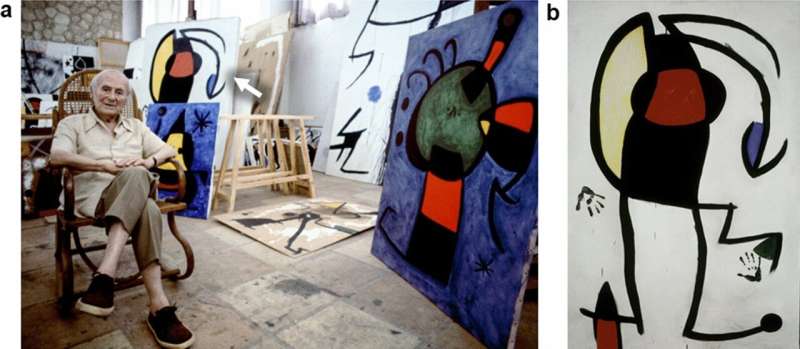This article has been reviewed according to Science X's editorial process and policies. Editors have highlighted the following attributes while ensuring the content's credibility:
fact-checked
proofread
Study explains the rapid deterioration of one of painter Joan Miró's favorite colors

A photo from 1978 shows famous Catalan surrealist painter Joan Miró in his Taller Sert, surrounded by his paintings. In the background, the bright, intense yellow of Femme dans le rue (1973), stands out. Fifty years later, that cadmium-based yellow is faded and chalky. The same phenomenon has affected 25 other paintings in the Fundació Miró Mallorca.
The degraded yellow paint used by Mirò is made from cadmium yellow, a modern pigment composed of cadmium sulfide and introduced in the late 19th century. The pigment was used extensively by artists such as Vincent Van Gogh, Pablo Picasso and Henri Matisse, who appreciated its brilliance and full-bodied tone. As discovered in recent years, however, this pigment can become unstable, leading to a deterioration of the paint, as in the case of important artworks such as Edward Munch's "The Scream."
The research conducted so far has provided an understanding of the degradation process, but has not completely clarified the latter's triggering factors. Furthermore, degradation is more evident in paintings dated between the end of the 19th and the beginning of the 20th century, at a time when the methods for synthesizing cadmium yellow pigment had not yet been perfected, while Miró's works were painted in the 1970s, in a much later period.
The Fundació Miró Mallorca collection therefore represents a unique case study for understanding the deterioration of this particular paint at a later stage in the history of cadmium yellow pigment production.
To shed light on the issue, the conservators turned to restorer Mar Gomez Lobon, who assembled an international team that included Italian scientists Daniela Comelli and Marta Ghirardello from the Politecnico di Milano and Francesca Caterina Izzo from Ca' Foscari University of Venice.
The researchers and their colleagues analyzed nine samples taken from the artist's paintings, paint tubes, and palettes, and used a multi-analytical approach: electron microscopy, X-ray fluorescence at the Grenoble synchrotron, infrared spectroscopy, micro photoluminescence and chromatographic analysis.
The paint's chemical composition and the crystalline structure of the pigments are the clues that lead the research team to argue that the degraded cadmium yellow came from paint tubes produced by the French brand Lucien Lefebvre-Foinet, a favorite of Miró's. More than 100 of this brand were found in his studios, including five of Cadmium Yellow Lime No.1, unrecognizable today. This was certainly not a cheap product: the Parisian house produced high quality colors that artists such as Mondrian, Matisse and Giacometti used.
"Its low crystallinity exposes the pigment to high photochemical reactivity. This is one of the main causes of the paint's vulnerability and can be traced back to the method by which the pigment was synthesized. Such method is, however, unknown, and no historical sources have yet been found," explains Daniela Comelli from the Physics Department of the Politecnico di Milano.
Finally, storage and environmental conditions strongly contributed to the material's chemical and physical transformation. Samples with the same chemical composition show different levels of degradation, and the best-preserved color comes from a palette that had remained locked in a drawer for 32 years, protected from light and changes in humidity.
"The preservation of Miró's and other artists' cadmium yellow requires control over environmental parameters such as exposure to light and relative humidity," explains Francesca Caterina Izzo of Ca' Foscari University of Venice. "When painted surfaces are severely degraded and therefore fragile, glazing with UV-filtering glass may help, while solutions involving the application of protective coatings, varnishes or consolidants require further study."
The research, published in the journal Heritage Science, was conducted by restorer Mar Gomez Lobon together with Marta Ghirardello and Daniela Comelli of the Politecnico di Milano, Enric Juncosa Darder of the Fundació Pilar i Joan Miró in Mallorca, Carlos Palomino Cabello and Marta Bauza of the Universitat de les Illes Balears, Marine Cotte of the European Synchrotron Radiation Facility, Austin Nevin, Aviva Burnstock and Silvia Rita Amato of The Courtauld Institute of Art, and Francesca Caterina Izzo of Ca' Foscari University of Venice.
Research into Miró's "mystery" yellow will continue with research on other colors of the Lucien Lefebvre-Foinet brand and on paintings containing cadmium yellow that were stored in similar conditions but do not show the same signs of decay.
Correction Note (12/6/2023): The name of the painter has been corrected from Juan Miró to Joan Miró.
More information: Mar Gomez Lobon et al, A study of cadmium yellow paints from Joan Miró's paintings and studio materials preserved at the Fundació Miró Mallorca, Heritage Science (2023). DOI: 10.1186/s40494-023-00987-4
Provided by Ca' Foscari University of Venice



















